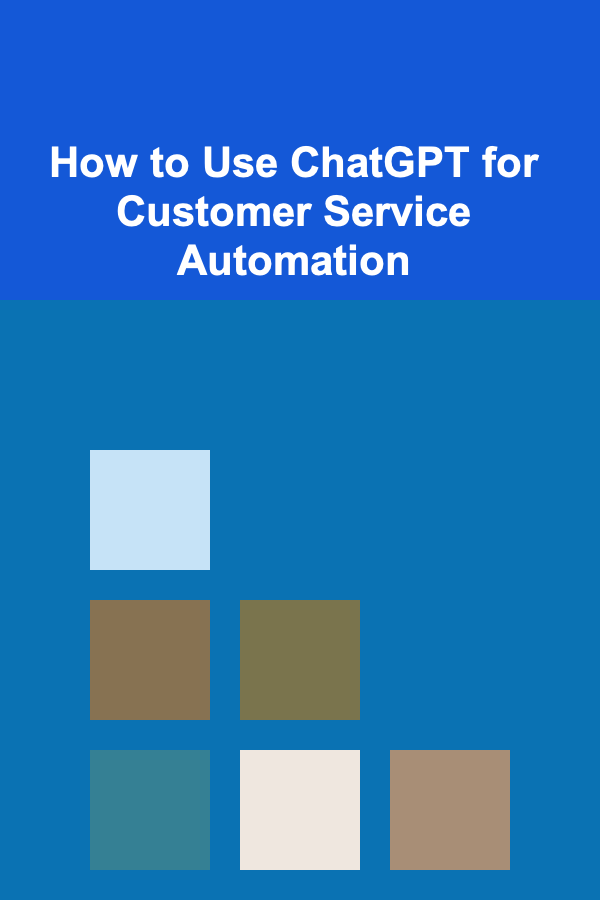
How to Use ChatGPT for Customer Service Automation
ebook include PDF & Audio bundle (Micro Guide)
$12.99$6.99
Limited Time Offer! Order within the next:

In recent years, the way businesses interact with customers has drastically changed. As technology continues to evolve, so do customer expectations. Consumers now expect faster response times, 24/7 availability, and personalized experiences when interacting with businesses. One of the most powerful tools available for achieving these goals is artificial intelligence (AI), specifically ChatGPT.
ChatGPT, developed by OpenAI, is an AI language model capable of understanding and generating human-like text. When applied to customer service automation, ChatGPT can significantly enhance operational efficiency, improve customer satisfaction, and reduce operational costs. This article will delve deep into how businesses can leverage ChatGPT for customer service automation, exploring its capabilities, benefits, and practical implementation strategies.
The Role of AI in Customer Service
Before we dive into the specifics of ChatGPT, it's important to understand the broader context of AI in customer service. AI-powered customer service tools have been gaining traction due to their ability to handle tasks traditionally performed by human agents. These tasks range from answering frequently asked questions (FAQs) to handling more complex inquiries, such as technical support or order tracking.
The integration of AI into customer service offers several key benefits:
- 24/7 Availability: AI-powered systems never need to rest. They can provide support at any hour of the day, ensuring that customers in different time zones or with urgent needs always have access to help.
- Instant Response Time: AI systems like ChatGPT can respond instantly to customer inquiries, dramatically reducing wait times that often frustrate customers.
- Cost Efficiency: Automating customer service with AI can reduce the need for a large team of human agents, leading to significant savings in labor costs.
- Consistency and Accuracy: AI systems provide consistent responses, reducing human error and ensuring that customers receive accurate information every time.
- Personalization: With access to customer data and advanced natural language processing (NLP), AI can tailor responses to the specific needs and preferences of individual customers.
ChatGPT, with its advanced conversational abilities, plays a pivotal role in enabling these benefits. It can handle a wide range of customer service tasks, from basic FAQs to more complex troubleshooting, and even assist with lead generation and sales.
How ChatGPT Works
ChatGPT is powered by OpenAI's GPT (Generative Pre-trained Transformer) models, which are trained on vast amounts of data from the internet. This training allows ChatGPT to generate human-like responses based on the input it receives. The model is capable of understanding context, maintaining coherent conversations, and answering questions in a way that feels natural to the user.
The key components that make ChatGPT effective for customer service automation include:
- Natural Language Understanding (NLU): ChatGPT has a deep understanding of language, allowing it to interpret customer queries accurately, even when phrased in different ways. Whether a customer asks a question formally or informally, ChatGPT can comprehend the intent behind the inquiry.
- Context Awareness: Unlike simple rule-based bots, ChatGPT can maintain context over the course of a conversation. This is particularly useful when customers need to provide additional information or when a query involves multiple steps.
- Scalability: ChatGPT can handle a virtually unlimited number of conversations simultaneously. This is especially beneficial for businesses that need to manage high volumes of customer interactions.
- Learning and Adaptation: Although ChatGPT doesn't "learn" from individual conversations, it can be fine-tuned to perform specific tasks based on training data. With proper input and feedback, businesses can tailor ChatGPT to their unique customer service needs.
Key Benefits of Using ChatGPT for Customer Service Automation
The integration of ChatGPT into customer service operations offers numerous advantages that can help businesses streamline processes and improve the overall customer experience.
1. Enhancing Customer Experience
Customers today expect quick and personalized service. ChatGPT can meet these expectations by providing immediate, consistent, and personalized responses to inquiries. By analyzing customer data and previous interactions, ChatGPT can offer relevant solutions, product recommendations, or even guide customers through troubleshooting steps.
The personalization aspect is particularly powerful. ChatGPT can recall past interactions and tailor responses based on the customer's preferences, previous purchases, or support history. This level of personalization can make customers feel valued and enhance their overall experience with the brand.
2. Reducing Operational Costs
Customer service departments often require significant investments in human agents, training, and infrastructure. By automating routine tasks, ChatGPT can reduce the workload on human agents, allowing them to focus on more complex or sensitive issues. This can lead to a reduction in staffing needs, lower training costs, and less operational overhead.
ChatGPT can also scale seamlessly, meaning that businesses can handle higher volumes of customer queries without needing to hire more agents or increase operational costs.
3. Improving Response Time and Availability
One of the most significant advantages of using ChatGPT for customer service is the reduction in response time. Traditional customer service models often involve long wait times, especially during peak hours. ChatGPT, however, can provide instant responses, ensuring that customers don't have to wait for assistance. This is particularly important in industries where speed is critical, such as e-commerce or technical support.
Furthermore, ChatGPT is available 24/7, ensuring that customers can get assistance at any time, regardless of time zone. This is especially beneficial for global businesses that operate in different regions.
4. Handling a Wide Range of Inquiries
ChatGPT can be trained to handle a variety of customer service tasks. These include:
- Frequently Asked Questions (FAQs): ChatGPT can handle common inquiries, such as store hours, return policies, or shipping information.
- Order Tracking: Customers can inquire about the status of their orders, and ChatGPT can retrieve relevant data to provide updates.
- Product Recommendations: Based on customer preferences and past purchases, ChatGPT can suggest products that are likely to interest the customer.
- Technical Support: ChatGPT can guide customers through troubleshooting steps for products or services, providing solutions to common technical issues.
- Lead Generation: ChatGPT can qualify leads by engaging with potential customers, asking questions about their needs, and collecting contact information.
5. Data Collection and Analytics
ChatGPT can collect valuable data from customer interactions, including insights into customer preferences, pain points, and common issues. This data can be used to improve products, services, and overall customer experience. Additionally, businesses can use this information to identify patterns and trends, helping them make data-driven decisions.
6. Reducing Human Error
Human agents are prone to mistakes, especially when dealing with a high volume of queries. ChatGPT, however, can maintain a consistent level of accuracy throughout every interaction. By eliminating human error, businesses can ensure that customers receive correct information every time, which can lead to improved customer trust and satisfaction.
How to Implement ChatGPT for Customer Service Automation
The process of implementing ChatGPT for customer service automation can be broken down into several key steps. Each step is crucial for ensuring that the system is set up correctly and functions smoothly.
1. Define Your Use Cases
The first step is to define the specific use cases for ChatGPT in your customer service department. Will it be used to answer general questions, handle technical support, assist with order tracking, or provide product recommendations? Identifying your goals will help you determine how ChatGPT should be configured and what kind of data it will need.
2. Train the Model
While ChatGPT comes pre-trained with general knowledge, businesses often need to fine-tune the model to align with their specific needs. This involves training the model on a dataset that includes customer queries, company-specific information, and responses. The goal is to ensure that ChatGPT understands your products, services, and business processes.
This can be achieved through a process known as supervised fine-tuning, where the AI is trained on a labeled dataset. The more relevant data you provide, the better ChatGPT will be at providing accurate and helpful responses.
3. Integrate with Existing Systems
For ChatGPT to be effective, it needs to be integrated with your existing customer service platforms. This includes your website's live chat, CRM systems, email, and other customer support channels. Integration allows ChatGPT to access relevant customer data, track interactions, and escalate issues to human agents when necessary.
4. Set Up Escalation Protocols
While ChatGPT can handle many queries, there will always be situations where a human touch is required. It's essential to set up escalation protocols to ensure that customers can easily transition to a live agent if needed. For example, if a customer has a complex issue or requests to speak with a human, ChatGPT should seamlessly transfer the conversation to a human representative.
5. Monitor and Optimize Performance
After implementing ChatGPT, it's important to continuously monitor its performance. Regularly review customer interactions, assess the quality of responses, and gather feedback from customers. If ChatGPT is not performing as expected, fine-tune the model or adjust its training data accordingly. This iterative process will help improve the system over time.
Challenges and Considerations
While ChatGPT offers many benefits, it's important to be aware of potential challenges:
- Complexity of Queries: ChatGPT may struggle with complex or highly specialized queries, requiring businesses to develop additional training data or escalation protocols.
- Data Privacy and Security: Handling sensitive customer data requires strict compliance with data privacy regulations. Ensure that ChatGPT adheres to security standards and protects customer information.
- Human Touch: While AI can handle many tasks, some customers may still prefer to speak with a human agent. Striking the right balance between automation and human interaction is crucial.
Conclusion
Using ChatGPT for customer service automation is a powerful way to enhance the customer experience, reduce operational costs, and improve efficiency. By leveraging its capabilities in natural language understanding, scalability, and personalization, businesses can offer round-the-clock support, faster response times, and a more engaging customer experience. However, successful implementation requires careful planning, training, and continuous optimization to ensure that ChatGPT meets your specific customer service needs. As AI technology continues to evolve, the potential for automating customer service will only grow, making it a vital tool for businesses looking to stay competitive in the digital age.

How to Craft a Communication Checklist for Software Implementation
Read More
How to Create a Ritual for Mindful Transitions
Read More
How to Develop a Strong Personal Brand
Read More
The Marketing Director's Playbook: Innovative Approaches to Brand Growth
Read More
How to Build a Greywater Recycling System
Read More
How to Plan a Web Design Project for Portfolio Websites
Read MoreOther Products

How to Craft a Communication Checklist for Software Implementation
Read More
How to Create a Ritual for Mindful Transitions
Read More
How to Develop a Strong Personal Brand
Read More
The Marketing Director's Playbook: Innovative Approaches to Brand Growth
Read More
How to Build a Greywater Recycling System
Read More